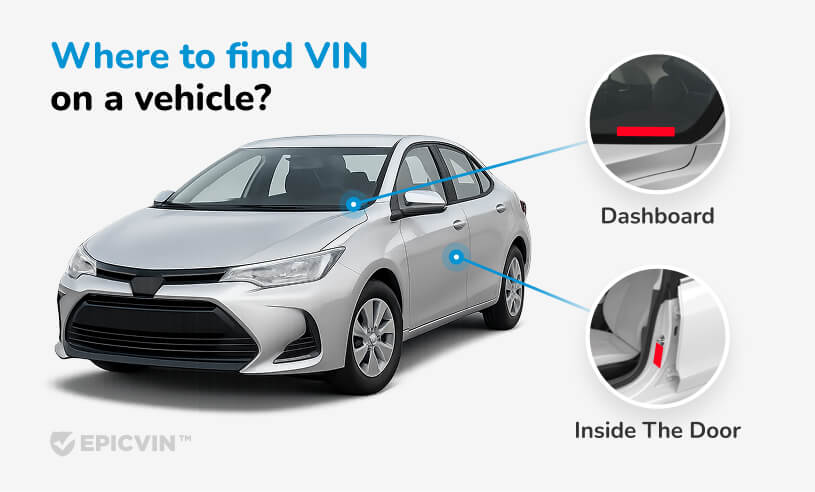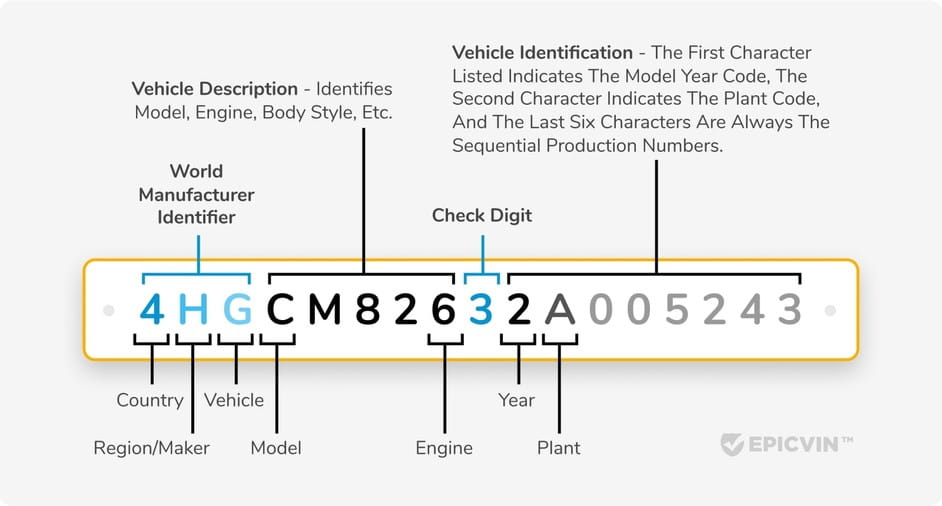
How to Read a VIN Number Like a Pro
From understanding the VIN number breakdown to uncovering a vehicle’s history,...

Free Kia VIN Decoder! 🚗 See specs, build sheet, recalls basic history—no sign-up. 🛡️✅ Need accidents, mileage, title? Upgrade in one click.
Looking for the VIN?
Here is there you’ll find it:

A KIA VIN is considered your vehicle's unique 17-character identifier. Such a sequence uncovers essential details about your car's specs, history, and safety status. This format consists of capital letters and numbers. In 1981, the NHTSA standardized it to ensure consistent vehicle identification across all manufacturers. Using a reliable VIN Decoder assists drivers in verifying authenticity, checking open recalls, and accessing vital maintenance records before making any purchase decision.
Interpreting your KIA VIN number is straightforward with our comprehensive VIN decoder tool.

Your KIA VIN location varies by vehicle but follows standard placement guidelines.
| Key Risk | Impact on Buyers | Mitigation Steps |
|---|---|---|
| High Theft Risk | HLDI logged 11.7 theft claims per 1,000 insured KIA vehicle-years - 8× industry norm. | Install KIA's free anti-theft software, add a steering-column lock, and store key fobs in a Faraday pouch. |
| Unrepaired Safety Recalls | 1.23 million KIAs on U.S. roads carry open recalls as of 12/31/2024. | Enter VIN on the KIA site and demand documentation that recalls are completed before purchase. |
| Depreciation Over Time | KIA retains ≈54% value after five years versus the 48% industry average. | Choose strong resale trims (Telluride SX), keep service records, and avoid heavy mods. |
| Odometer Rollback Fraud | EpicVIN flags 2.2 million rollback cases; ≈40k involve KIAs. | Match DMV title mileage to auction photos and service receipts via EpicVIN. |
| Hidden Flood/Salvage History | 347,000 flood-damaged cars after 2024 hurricanes; roughly 14k wear KIA badges. | Verify NMVTIS \"water\" brands, inspect seat-bolt rust, and avoid missing title chains. |
Always check your VIN through EpicVIN, compare mileage with DMV and auction photos, and use an endoscope during inspection - it's affordable but quickly reveals water damage and corrosion signs.
| Issue | Affected Models, Symptoms, Average Repair Cost |
|---|---|
| Theta II rod-bearing wear/engine seizure | 2011-2021 Optima, Sorento, Sportage (60–120k mi); knocking then stalling. Re-manufactured long-block $3,500–6,500. |
| 7-speed DCT overheating & limp mode | 2016-2022 Forte, Niro, Seltos (20–80k mi); \"Transmission Hot\" light, loss of power. Clutch pack & TCU $1,500–4,000. |
| ABS/HECU electrical short fire risk | 2014-2022 Sportage, Cadenza, K900 (any mileage); burning smell, battery drain. Module replacement $800–2,400 unless recall is honored. |

Each character in your vehicle's unique sequence tells a specific story about production features and technical specifications.
Here's how our KIA VIN decoder interprets a sample sequence (KNDJ23AU4N7123456):
| Symbols | Sample | What It Reveals |
|---|---|---|
| 1 | K | South Korea as the country of origin |
| 2 | N | Kia as a manufacturer |
| 3 | D | Passenger car vehicle type |
| 4-8 | J23AU | Sedan body style, engine type, restraint system, Forte model line, trim level |
| 9 | 4 | Check digit for validation |
| 10 | N | 2022 model year |
| 11 | 7 | Hwaseong, South Korea assembly plant |
| 12-17 | 123456 | Individual vehicle serial number |
Year 2020
Make Kia
Model Sportage
Fuel Type Gasoline
Engine 2.4L GDI THETA II
Made in SOUTH KOREA
Our database already covers 8 million active KIA registrations in the U.S., so we can benchmark any VIN against the entire fleet in seconds.Alex Black, CMO, EpicVIN
Position 5 in the VIN reveals engine type and displacement details for specifications analysis.
Position 11 shows assembly plant: 7=Hwaseong, 5=West Point, Georgia, manufacturing location.
No, towing packages appear in option codes, not VIN digits on the windshield.
Compare DMV records with auction photos and service receipts to identify mileage history.
The window sticker and dashboard contain scannable VIN barcodes visible through the windshield.
Yes, contact KIA with your VIN for software update eligibility through their account system.
Position 8 indicates battery capacity: H=64kWh, J=77kWh for EV6/EV9 vehicle specifications.
Yes, our database archives salvage auction photos for the timeline review of vehicle history and maintenance records.
Discover expert tips, news and advice on buying and maintaining used vehicles

From understanding the VIN number breakdown to uncovering a vehicle’s history,...

Read the article to find out how to get your towed car back without too much t...

Whether you are looking for a new or used vehicle, there are specific times of...